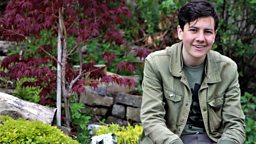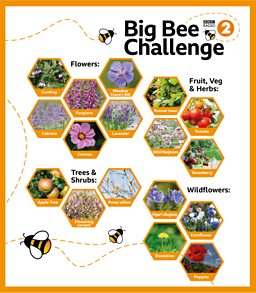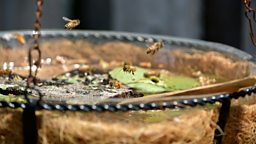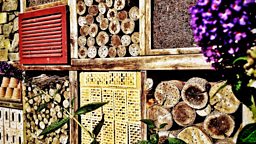Designing your bee-friendly garden: What you need to know

Our bees are in trouble - and we need to help save them!
Around the UK, bees and other wild insects are in decline. There are many reasons for this, but it's partly because there are fewer of the flowers and plants that they need to survive.
We can all do our bit to help keep the bees buzzing, which is why we've been asking children to design a bee-friendly garden, that we’re going to build for the NHS.
While the competition has now closed, the plight of the bees continues. We want ALL of us to be inspired to get out there and do our bit, in our gardens, backyards, pots and balconies, to help our precious pollinators.
Without bees our world would look very different, the work they do pollinating our fruit, vegetables and crops puts food on our plates!
What bees need
They really only need three things to thrive:
- Something to eat
- Something to drink
- Somewhere sheltered to nest or rest
Award-winning young gardener George Hassall, often found pottering in the Blue Peter garden, has some top tips for a bee-friendly garden…

1. Host a Bee Buffet….Grow plants with nectar and pollen
Bees need flowers and flowers need bees! Flowers provide bees with nectar for food and pollen to feed their young, and at the same time the bees pollinate the flowers, helping to create more flowers. So pick some flowers and plants that are bee favourites.
Choose plants that are nectar rich throughout the seasons for the bees who appear late in winter and stick around long after summer.George Hassall
George says: "Let's start with the obvious stuff - pollinating plants, shrubs and flowers. Choose plants that are nectar rich throughout the seasons for the bees who appear late in winter and stick around long after summer. So we’ve got winter hellebores, pulmonaria that flowers really early spring, summer is sorted and Michaelmas daisies, which are fab come late autumn."
Top Tip: Choose flowers with single petals.
Some flowers have too many petals which the bees can’t get past, or which don’t have enough nectar.
Here are a few suggestions to get you started...

Trees for the Bees
The bees often use trees to navigate when flying around. Fruit trees such as apple, pear and cherry are a perfect source of food in the spring time for our buzzy friends and some bees use them to nest, and rest! As an added bonus for us, you can eat the fruit too!
Let it Grow...

Mowing our gardens a little less, and letting the grass grow long is another great way to help the bees. Dandelions will begin to pop up, they are a great early source of food for bees in springtime. And you’re more likely to spot a greater variety of flowers popping up in your garden such as daisies and buttercups that the bees will love.
Make a space that's born to be wild, where stuff like dandelions and white & red clover are left to grow.George Hassall
George says: "Make a space that's born to be wild, where stuff like dandelions and white & red clover are left to grow. Like 'organised chaos'"
One of your five a day…
Did you know bees also help pollinate our food? So think about what fruit, vegetables and herbs could grow in your garden. Sometimes gardeners like to grow these in pots or planters or raised beds. Try peas and cucumbers, rosemary and chives and don’t forget strawberries and raspberries. These are really simple to grow.
George says: "So, we grow purple sprouting broccoli. Come March time, we harvest some to scoff and then we leave the rest to go to seed, the bees are absolutely crazy for their yellow flowers, when there’s not much else around. Oh and don’t forget herbs, the bees are mad for marjoram, thyme and lavender. So for me, it's about designs that show us how to share our gardens with wildlife, it's win-win then."
Need some inspiration?
2. Being a busy bee is thirsty work...

Like all of us, the bees need a drink! The best water sources for bees are ones that won’t go dry in the summer, won’t drown the bees, and won’t be shared with pets.
I’m a bit potty about ponds, but a plate or bowl would do the trickGeorge Hassall
What kind of watering station will you put in your garden?
George says: "A water source for a drink – I’m a bit potty about ponds, but a plate or bowl would do the trick."
A small pond will be a welcome addition and not only for the bees. Make your pond safe for bees, by including a safe space to land and stand, by adding some water plants.
Water in a steep-sided container or water that flows quickly is dangerous to a bee because they can easily drown. If you use a container, you can add anything that floats such as corks, sticks or sponges, this will help the bees drink safely.
Need some inspiration?
3. Give me shelter

Bees also need somewhere to rest and nest, lay their eggs and protect them whilst they grow. Different bees need different spaces; honeybees lives in beehives, but there are more than 250 other species of bee in the UK who have different homes, from birdboxes and trees, to small holes in buildings or in the short grass and dusty ground.
I’d like to see holes in walls for solitary bees, those kind of details would give me a buzzGeorge Hassall
What options will you give them in your garden?
You could try a simple upturned Terracotta pot filled with dried grass, a rotting log with holes, a multi-storey bee hotel or a small wild space in the corner.
George says: "There’s lots of different types of habitats – there’s 5* boutique bee & bug hotels and another thing I like to see, is holes in walls for solitary bees.”
Have a go at home:
Disclaimer: Third-party videos may contain adverts.
Finally, have fun and be creative!
Now you need to think about where the human visitors to your garden will sit and watch the bees buzz by. Are there any secret spots or hidey holes? What about a shady area or a sunny corner? How about a place where you can sit and chat with friends and family, and somewhere for a quiet moment to yourself.
Bee inspired, bee creative, make those bees happy and design a wildlife garden of dreams.George Hassall, award-winning young gardener
George says…
"I entered a gardening competition when I was 8, I never thought in a million years that I would win, but I did, and now I always say, ‘gardening changed my life’. Gardening makes me feel relaxed, it really chills me out, especially if I’ve had a tough day at school and as a family it makes us all come together. And we have a right laugh.
"Bee inspired, bee creative, make those bees happy and design a wildlife garden of dreams."
